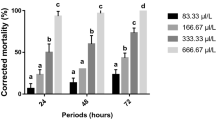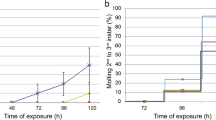Abstract
The effect of botanical insecticides and bacterial toxins on gut enzyme activity of larvae of the rice leaffolderCnaphalocrocis medinalis (Guenée) (Insecta: Lepidoptera: Pyralidae) was investigated. Gut enzyme activities were affected by botanical insecticides and bacterial toxin individually and in combination. When fed a diet of rice leaves treated with botanical insecticides and bacterial toxins, in bioassays the activities of gut tissue enzymes — acid phosphatases (ACP), alkaline phosphatases (ALP) and adenosine triphosphatases (ATPase) — of rice leaffolder larvae were affected. When combined, the effect was more severe at a low concentration. Larvae that were chronically exposed to botanical insecticides and bacterial toxins showed a reduction in weight (59–89%) and exhibited a significant reduction in ACP, ALP and ATPase activities. The combination ofBacillus thuringiensis kurstaki and botanical insecticides caused a decrease of twofold in enzyme activity even at reduced concentration. A synergistic effect was found when botanical insecticides and bacterial toxins were combined at low doses. These effects were most pronounced in early instars. Clear dose-response relationships were established with respect to enzyme activity. In conclusion: (i) biopesticides are relatively safe and biodegradable; (ii) a synergistic effect of botanical insecticides and bacterial toxins was found; (iii) less expensive, readily available and naturally occurring biopesticides could be an alternative for organic and inorganic pesticides in controlling RLF.
Similar content being viewed by others
References
Applebaum, S.W. (1964) The action pattern and physiological role ofTenebrio larval amylase.J. Insect Physiol. 10:897–906.
Applebaum, S.W., Jankovic, M. and Birk, Y. (1961) Studies on the midgut amylase activity ofTenebrio molitor L.larvae.J. Insect Physiol. 7:100–108.
Babu, R., Murugan, K. and Vanithakumari, G. (1996) Interference of Azadirachtin on the food utilization efficiency and midgut enzymatic profiles ofHelicoverpa armigera.Indian J. Environ. Toxicol. 6:81–84.
Bautista, R.C., Heinrichs, E.A. and Rejesus, R.S. (1984) Economic injury levels for the rice leaffolderCnaphalocrocis medinalis (Lepidoptera: Pyralidae). Insect infestation and artificial leaf removal.Environ. Entomol. 13:439–443.
Bessey, O.A., Lowry, O.H. and Brock, M.J. (1946) A method for the rapid determination of alkaline phosphatase with five cubic millimeters of serum.J. Biol. Chem. 164:321–329.
Bobrowski, V.L., Pasquali, G., Bodanese-Zanettini, M.H., Pinto, L.M.N. and Fiuza, L.M. (2002) Characterization of twoBacillus thuringiensis isolates from South Brazil and their toxicity againstAnticarsia gemmatalis (Lepidoptera, Noctuidae).Biol. Control 25:129–135.
Broadway, R.M. and Duffey, S.S. (1988) The effect of plant protein quality on insect digestive physiology and the toxicity of plant proteinase inhibitors.J. Insect Physiol. 34:1111–1117.
Butterworth, J.H. and Morgan, E.D. (1968) Isolation of a substance that suppresses feeding in locust.Chem. Comm. 1:23–24.
Chapman, R.F. (1985) Structure of the digestive systems.in: Kerkut, G.A. and Gilbert, L.I. [Eds.] Comprehensive Insect Physiology Biochemistry and Pharmacology. Vol. 4. Pergamon Press, Oxford, UK. pp. 165–211.
Dale, D. (1994) Insect pests of rice plant — their biology and ecology.in: Heinrichs, E.A. [Ed.] Biology and Management of Rice Insects. Wiley Eastern Ltd., New York, NY. pp. 363–485.
Eguchi, M., Sawaki, M. and Suzuki, Y. (1972) Multiple forms of midgut alkaline phosphatase in the silkworm: New band formation and the relationship between the midgut and digestive fluid.Insect Biochem. 2:297–304.
Fiske, C.H. and Subbarow, Y. (1925) The colorimetric determination of phosphorus.J. Biol. Chem. 66:375–400.
Fogg, K.E., Anstee, J.H. and Hyde, D. (1991) Studies on the subcellular distribution of (Na++ K+)-ATPase, K+-stimulated ATPase and HCO3-stimulated ATPase activities in malpighian tubules ofLocusta migratoria L.Insect Biochem. 21:749–758.
Hedin, P.A. (1991) Use of natural products in pest control. in: Hedin, P.A [Ed.] Naturally Occurring Pest Bioregulators. ACS Symp. Ser., American Chemical Society, Washington, DC. pp. 1–11.
Heong, K.L. (1993) Rice leaffolders: are they serious pests?in: Research on Rice Leaffolder Management in China.Proc. Int. Workshop on Economic Threshold for Rice Leaffolder in China (Beijing, China, 1992), pp. 8–11.
Hori, K. (1969) Effect of various activators on the salivary amylase of the bugLygus disponsi.J. Insect Physiol. 15:2305–2317.
Horie, B. (1958) The alkaline phosphatase in the midgut of silkworm,Bombyx morio L.Bull. Seric. Exp. Stn. (Tokyo) 15:275–289.
Lechleitner, R.A. and Phillips, J.E. (1988) Anion stimulated ATPase in locust rectal epithelium.Can. J. Zool. 66:431–438.
Mathavan, S., Sudha, P.M. and Pechimuthu, S.M. (1989) Effect ofBacillus thuringiensis israelensis on the midgut cells ofBombyx mori larvae: a histopathological and histochemical study.J. Invert. Pathol. 53:217–227.
Miao, Y.G. (1988) Study on the alkaline phosphatase in the midgut of domestic silkworm,Bombyx mori.Acta Seric. Sin. 14:154–158.
Miao, Y.G. (2002) Studies on the activity of the alkaline phosphatase in the midgut of infected silkworm,Bombyx mori L.J. Appl. Entomol. 126:138–142.
Morris, O.N., Trottier, M., Concerse, V. and Kanagarathinam, K. (1996) Toxicity ofBacillus thuringiensis subsp.aizwai forMamestra configurata (Lepidoptera, Noctuidae).J. Econ. Entomol. 89:359–365.
Murugan, K., Sivaramakrishnan, S., Senthil Kumar, N., Jeyabalan, D. and Senthil Nathan, S. (1998) Synergistic interaction of botanical insecticides and biocides (Nuclear Polyhedrosis virus) on pest control.J. Sci. Ind. Res. (India) 57:732–739.
Navon, A. (1993) Control of lepidopteran pests withBacillus thuringiensis.in: Entwistle, P.F., Cory, P.H., Bailey, J.S. and Higgs, S. [Eds.]Bacillus thuringiensis, an Environmental Biopesticide, Theory and Practice. Wiley, New York, NY. pp. 125–146.
Navon, A. (2000)Bacillus thuringiensis insecticides in crop protection — reality and prospects.Crop Prot. 19:669–676.
Ramachandran, R., Raffa, R.K., Miller, M.J., Ellis, D.D. and McCown, B.H. (1993) Behavioral responses and sublethal effects of spruce budworm (Lepidoptera, Tortricidae) and fall web worm (Lepidoptera, Arctitidae) larvae toBacillus thuringiensis cry 1A (a) toxin in diet.Environ. Entomol. 22:197–211.
Sakharov, I.Y., Makarova, I.E. and Ermolin, G.A. (1989) Chemical modification and composition of tetrameric isozyme K of alkaline phosphatase from harp seal intestinal mucosa.Comp. Biochem. Physiol B 92:119–122.
SAS Institute (1988) SAS/GRAPH User’s Guide, Release 6.03 Edition. Cary, NC, USA.
Schmutterer, H. (1990) Properties and potential of natural pesticides from the neem tree,Azadirachta indica.Annu. Rev. Entomol. 35:271–297.
Senthil Nathan, S., Murugan, K. and Kalaivani, K. (1999) Effect of azadirachtin andBacillus thuringiensis (Berliner) on the behavioral and physiological response ofCnaphalocrocis medinalis Guenée (Rice leaf folder). in: Murugan, K. [Ed.]Proc. National Symp. on Biological Control of Insects in Agriculture, Forestry, Medicine and Veterinary Science (Coimbatore, TN, India), Vol. 1, pp. 31–35.
Shiosaka, T., Okuda, H. and Fujii, S. (1971) Mechanism of the phosphorylation of thymidine by the culture filtrate ofClostridium perfringens and rat liver extract.Biochim. Biophys. Acta 246:171–183.
Sibley, R.M. (1981) Strategies of digestion and defaecation.in: Townsend, C.R. and Calew, P. [Eds.] Physiological Ecology and Evolutionary Approach to Resource Use. Blackwell Publishers, Oxford, UK. pp. 109–139.
Smirle, M.J., Lowery, D.T. and Zurowski, C.L. (1996) Influence of Neem oil on detoxication enzyme activity in the obliquebanded leafroller,Choristoneura rosaceana.Pest. Biochem. Physiol. 56:220–230.
Tabashnik, B.E., Cushing, N.L., Finson, N. and Johnson, M.W. (1990) Field development of resistance toBacillus thuringiensis in diamondback moth.J. Econ. Entomol. 83:1671–1676.
Author information
Authors and Affiliations
Corresponding author
Additional information
http://www.phytoparasitica.org posting Sept. 28, 2004.
Rights and permissions
About this article
Cite this article
Nathan, S.S., Chung, P.G. & Murugan, K. Effect of botanical insecticides and bacterial toxins on the gut enzyme of the rice leaffolderCnaphalocrocis medinalis . Phytoparasitica 32, 433–443 (2004). https://doi.org/10.1007/BF02980437
Received:
Accepted:
Issue Date:
DOI: https://doi.org/10.1007/BF02980437




